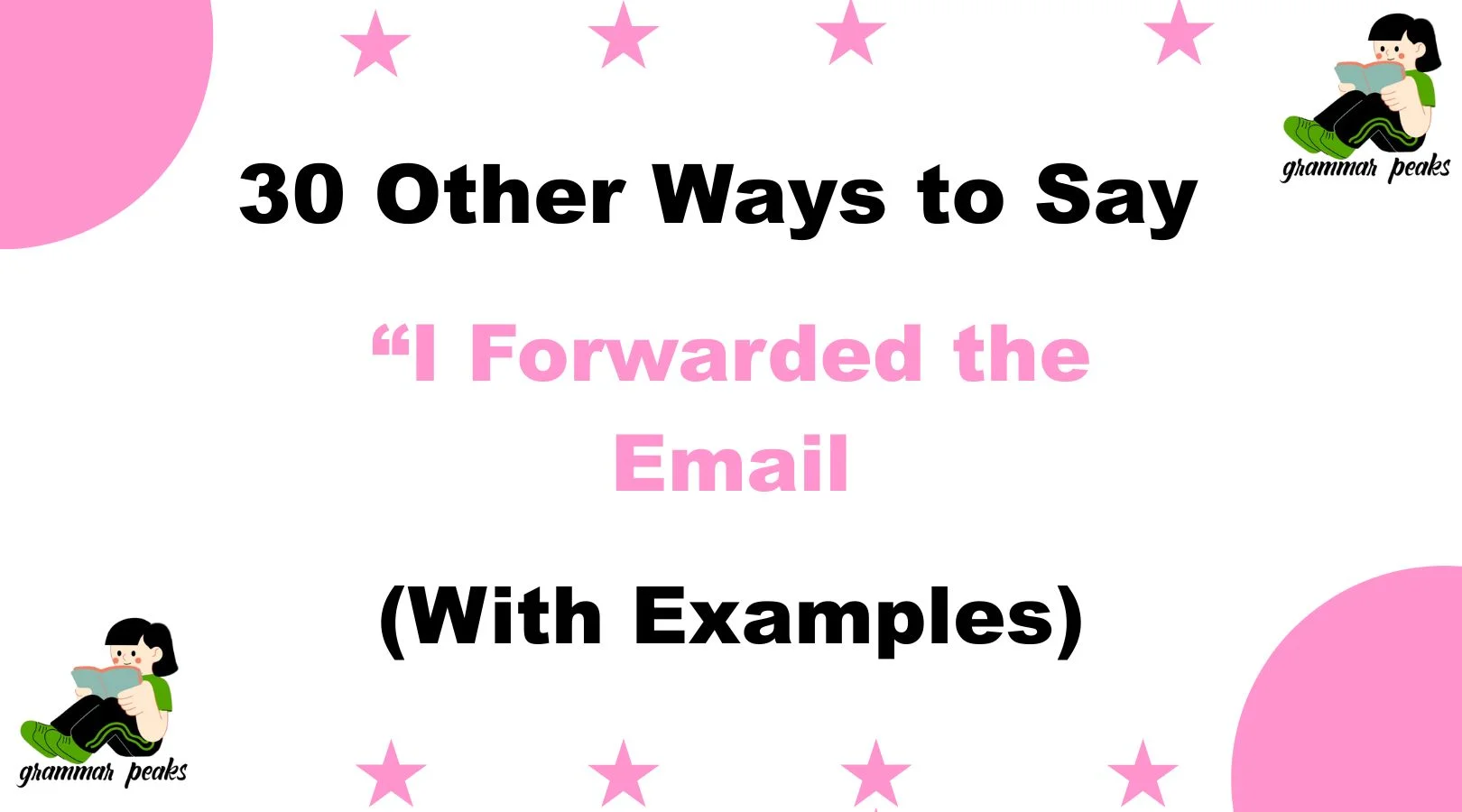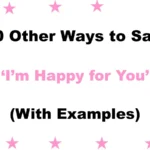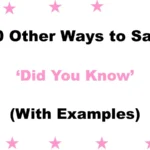In professional communication, how we say things matters—especially when it comes to something as routine yet important as forwarding an email. Whether you’re informing a manager, client, or colleague, using the right alternative can make your message sound more polished, proactive, and context-appropriate.
Below are 30 alternative ways to say “I forwarded the email”, each with definitions, examples, tone suggestions, and best/worst use cases to help you communicate with clarity and professionalism.
What Does “I Forwarded the Email” Mean?
“I forwarded the email” means that you sent an existing email you received to another person, often for informational or follow-up purposes. It is commonly used in workplace settings to share conversations, files, or updates.
When to Use “I Forwarded the Email”
Use this phrase when you’ve shared an existing email with another person for visibility, action, or collaboration. It’s appropriate in most business contexts but can benefit from rephrasing depending on your relationship with the recipient or the tone of your message.
Is It Professional/Polite to Say “I Forwarded the Email”?
Yes, it is technically professional—but it may sound overly basic or transactional. Alternatives can add nuance, especially if you want to emphasize why you forwarded it or draw attention to key information.
Pros and Cons of Saying “I Forwarded the Email”
Pros:
- Clear and direct
- Commonly understood
- Neutral in tone
Cons:
- Can sound impersonal or robotic
- Doesn’t emphasize the reason or importance
- May appear passive or reactive rather than helpful
Synonyms For “I Forwarded the Email”
- I Passed It Along
- I Sent It Over
- I Shared the Email
- I’ve Forwarded It to Them
- I’ve Loop Them In
- I’ve Handed It Off
- I’ve Submitted It
- I’ve Sent It Through
- I’ve Relayed the Message
- I’ve Addressed It to Them
- I’ve Sent It to the Right Person
- I’ve Forwarded It to the Team
- I’ve Emailed It Over
- I’ve Taken Care of Forwarding It
- You Should Have It Now
- I’ve Sent That Email Forward
- I’ve Directed It to the Right Contact
- I’ve Shared That With [Name/Team]
- I’ve Pushed It Forward
- I’ve Transferred the Email to [Department]
- I’ve Put It in Their Hands
- I’ve Made Sure They Got It
- The Email Has Been Sent Forward
- I’ve Dispatched the Email
- I’ve Referred This to [Name/Team]
- I’ve Taken the Liberty of Forwarding It
- I’ve Notified Them via Email
- I’ve Escalated This Via Email
- I’ve Communicated This to Them
- I’ve Sent That Message Forward
1. I’ve Sent the Email Along
Definition: A casual and conversational way to say you’ve forwarded an email.
Detailed Explanation: Implies you’ve passed the message to someone else without sounding too formal.
Scenario Example: “I’ve sent the email along to the team—they’ll review it today.”
Best Use: Internal teams or informal updates.
Worst Use: Formal client communications.
Tone: Friendly, casual.
2. I Passed It Along
Definition: A relaxed alternative that suggests informal sharing of the email content.
Detailed Explanation: Commonly used in team settings or among peers.
Scenario Example: “I passed it along to Mark—he should get back to you soon.”
Best Use: Peer-to-peer conversations.
Worst Use: Formal corporate updates.
Tone: Conversational, easygoing.
3. I’ve Shared the Email
Definition: Emphasizes distribution rather than technical forwarding.
Detailed Explanation: Suggests the content of the email was shared intentionally for collaboration.
Scenario Example: “I’ve shared the email with our finance team for review.”
Best Use: Project discussions, cross-departmental messages.
Worst Use: When legal or strict wording is required.
Tone: Polite, professional.
4. I Sent It Over
Definition: Quick and simple way to say you’ve forwarded something.
Detailed Explanation: Sounds more active and less robotic than “I forwarded it.”
Scenario Example: “I sent it over to Lisa this morning.”
Best Use: Informal updates and team check-ins.
Worst Use: With senior leadership or formal communication.
Tone: Casual, responsive.
5. It’s Been Forwarded to Them
Definition: Slightly passive construction that confirms the action has been taken.
Detailed Explanation: Suitable when the forwarding is procedural or doesn’t require follow-up.
Scenario Example: “It’s been forwarded to HR—they’ll be in touch.”
Best Use: Updates or status messages.
Worst Use: When more context or explanation is needed.
Tone: Neutral, factual.
6. I’ve Loop Them In
Definition: Emphasizes inclusion and collaboration rather than just forwarding.
Detailed Explanation: A modern phrase that implies you’ve added someone to the conversation.
Scenario Example: “I’ve looped Amanda in—she’ll take it from here.”
Best Use: Group discussions and multi-person threads.
Worst Use: When formal or technical precision is needed.
Tone: Collaborative, informal.
7. I’ve Included Them in the Thread
Definition: Specifies that someone has been added to the ongoing email chain.
Detailed Explanation: Helpful for clarifying that you didn’t start a new email but continued the current one.
Scenario Example: “I’ve included Sam in the thread for visibility.”
Best Use: Group or cross-functional communication.
Worst Use: When you’ve sent a new email, not added them to the same one.
Tone: Precise, polite.
8. I’ve Forwarded It for Review
Definition: Adds a purpose to the action—forwarding with intent.
Detailed Explanation: Great for formal settings where approval or review is needed.
Scenario Example: “I’ve forwarded it to the compliance team for review.”
Best Use: Compliance, legal, or approval workflows.
Worst Use: For casual updates.
Tone: Formal, purposeful.
9. The Email Has Been Sent to [Name]
Definition: Clear and professional notification of email forwarding.
Detailed Explanation: Useful when you want to emphasize the recipient of the message.
Scenario Example: “The email has been sent to our legal department as requested.”
Best Use: Client communications, external partners.
Worst Use: Too stiff for everyday team chats.
Tone: Formal, structured.
10. I’ve Relayed the Message
Definition: Suggests you’ve passed along the content, not just the email.
Detailed Explanation: Great when the content matters more than the original format.
Scenario Example: “I’ve relayed the message to support—they’ll respond shortly.”
Best Use: Support, logistics, or situations where urgency matters.
Worst Use: When someone is expecting the literal email copy.
Tone: Supportive, action-driven.
11. I’ve Sent It to the Right Person
Definition: Indicates you’ve shared the email with the person best equipped to handle it.
Detailed Explanation: Helps convey efficiency and purposeful action.
Scenario Example: “I’ve sent it to the right person on our team—they’ll follow up soon.”
Best Use: Delegating responsibility or redirecting inquiries.
Worst Use: If the recipient doesn’t know who that person is.
Tone: Helpful, professional.
12. I’ve Forwarded It to the Team
Definition: Clearly communicates that the entire team now has access to the email.
Detailed Explanation: Common in group project or department updates.
Scenario Example: “I’ve forwarded it to the team so we’re all on the same page.”
Best Use: Team alignment and transparency.
Worst Use: For highly confidential information.
Tone: Inclusive, collaborative.
13. I’ve Emailed It Over
Definition: Informal way of saying you’ve sent or forwarded the email.
Detailed Explanation: Less rigid and more conversational.
Scenario Example: “I’ve emailed it over—let me know if anything’s missing.”
Best Use: Internal communication or quick follow-ups.
Worst Use: With clients or executives.
Tone: Casual, conversational.
14. I’ve Taken Care of Forwarding It
Definition: Focuses more on the action being completed.
Detailed Explanation: Subtly emphasizes that the task is done.
Scenario Example: “I’ve taken care of forwarding it to the billing department.”
Best Use: When you’re reporting completed tasks.
Worst Use: When the recipient needs more specific info.
Tone: Confident, efficient.
15. You Should Have It Now
Definition: Implies that the email was just forwarded and should be in the recipient’s inbox.
Detailed Explanation: Helpful in real-time communication.
Scenario Example: “You should have it now—let me know if it didn’t come through.”
Best Use: Live chat, phone calls, or instant messaging.
Worst Use: In formal written reports.
Tone: Immediate, informal.
16. I’ve Sent That Email Forward
Definition: A slightly altered version of the original phrase with a smoother tone.
Detailed Explanation: Still clear but slightly more polished.
Scenario Example: “I’ve sent that email forward to the ops team.”
Best Use: When relaying info without sounding repetitive.
Worst Use: For legal or highly structured documentation.
Tone: Semi-formal, clear.
17. I’ve Directed It to the Right Contact
Definition: Focuses on ensuring the email reached the appropriate recipient.
Detailed Explanation: Conveys responsibility and control over the process.
Scenario Example: “I’ve directed it to the right contact for further handling.”
Best Use: Client-facing or interdepartmental communication.
Worst Use: If you’re unsure who the right contact is.
Tone: Professional, confident.
18. I’ve Shared That With [Name/Team]
Definition: Flexible phrase for letting someone know you passed along the info.
Detailed Explanation: Keeps communication warm and respectful.
Scenario Example: “I’ve shared that with Rachel from tech support.”
Best Use: Cross-functional projects or updates.
Worst Use: When strict confirmation of email format is needed.
Tone: Approachable, cooperative.
19. I’ve Pushed It Forward
Definition: Suggests forwarding something for the sake of progress.
Detailed Explanation: Often used in workflow or status updates.
Scenario Example: “I’ve pushed it forward to get their input.”
Best Use: Project momentum or when acting as a liaison.
Worst Use: If taken too literally (sounds vague).
Tone: Proactive, informal.
20. I’ve Transferred the Email to [Department]
Definition: More formal and structured alternative.
Detailed Explanation: Best used when dealing with process-heavy environments.
Scenario Example: “I’ve transferred the email to our risk compliance team.”
Best Use: Legal, finance, IT, or HR communications.
Worst Use: In quick or casual emails.
Tone: Formal, process-driven.
21. I’ve Put It in Their Hands
Definition: Metaphorical expression implying the task is now someone else’s responsibility.
Detailed Explanation: Great when you want to signal handoff.
Scenario Example: “I’ve put it in their hands—they’ll circle back soon.”
Best Use: Hand-offs, follow-up messages.
Worst Use: With people unfamiliar with idioms or metaphors.
Tone: Relaxed, metaphorical.
22. I’ve Made Sure They Got It
Definition: Reassures the sender that the email was successfully received.
Detailed Explanation: Useful when someone is concerned about delivery.
Scenario Example: “I’ve made sure they got it and are looking into it.”
Best Use: Client relations, reassurance.
Worst Use: If confirmation hasn’t actually been received.
Tone: Reassuring, professional.
23. The Email Has Been Sent Forward
Definition: Passive, more formal version.
Detailed Explanation: Useful when you want to sound neutral or procedural.
Scenario Example: “The email has been sent forward to the relevant department.”
Best Use: Status updates, report summaries.
Worst Use: One-on-one team conversations.
Tone: Neutral, formal.
24. I’ve Dispatched the Email
Definition: A formal, slightly technical way to say the email has been sent.
Detailed Explanation: Often used in administrative or operations contexts.
Scenario Example: “I’ve dispatched the email to our legal counsel.”
Best Use: Admin work or formal documentation.
Worst Use: Casual conversations.
Tone: Formal, procedural.
25. I’ve Referred This to [Name/Team]
Definition: Focuses on delegation or rerouting.
Detailed Explanation: Often used when forwarding something for action or decision-making.
Scenario Example: “I’ve referred this to operations for further review.”
Best Use: Escalations or support hand-offs.
Worst Use: When “forward” needs to be explicitly stated.
Tone: Professional, authoritative.
26. I’ve Taken the Liberty of Forwarding It
Definition: Polished phrase to indicate proactive forwarding.
Detailed Explanation: Communicates initiative in a courteous way.
Scenario Example: “I’ve taken the liberty of forwarding it to our analytics team.”
Best Use: When trying to impress or reassure.
Worst Use: When it might be interpreted as overstepping.
Tone: Polite, formal.
27. I’ve Notified Them via Email
Definition: Suggests you used email to communicate key information.
Detailed Explanation: Doesn’t specify forwarding, but achieves similar clarity.
Scenario Example: “I’ve notified them via email about the issue.”
Best Use: Task updates, reporting.
Worst Use: When exact content sharing is needed.
Tone: Clear, informative.
28. I’ve Escalated This Via Email
Definition: Indicates the matter has been forwarded with urgency or priority.
Detailed Explanation: Ideal for fast-moving or critical issues.
Scenario Example: “I’ve escalated this via email to ensure immediate review.”
Best Use: Urgent project workflows or client escalations.
Worst Use: For routine or low-priority matters.
Tone: Serious, proactive.
29. I’ve Communicated This to Them
Definition: Suggests you’ve sent the email and more (perhaps a summary or clarification).
Detailed Explanation: Broader than just forwarding—implies effort in communication.
Scenario Example: “I’ve communicated this to the support team—they’re working on it.”
Best Use: When you want to highlight active involvement.
Worst Use: When someone expects to see the actual email.
Tone: Thorough, collaborative.
30. I’ve Sent That Message Forward
Definition: Polished, slightly more elegant version of the original phrase.
Detailed Explanation: Keeps things formal and to the point.
Scenario Example: “I’ve sent that message forward to the leadership group.”
Best Use: Executive briefings or project reports.
Worst Use: In overly casual settings.
Tone: Professional, respectful.
FAQs About Saying “I Forwarded the Email”
1. Is it professional to say “I forwarded the email”?
Yes, it’s professional, especially in neutral or internal business contexts. However, if you’re communicating with executives, clients, or in formal reports, choosing a more polished variation can improve tone and clarity.
2. What’s a more formal way to say “I forwarded the email”?
More formal alternatives include:
- “I’ve transferred the email”
- “I’ve referred this to the appropriate department”
- “The email has been dispatched to the relevant party”
3. What can I say instead of “I forwarded the email” to sound more polite?
Try:
- “I’ve taken the liberty of forwarding it”
- “I’ve shared that with the team”
- “I’ve directed it to the appropriate person”
These maintain professionalism while softening the delivery.
4. Can I use these phrases in emails with clients?
Yes, but choose ones with a respectful tone like:
- “I’ve sent it to the right contact”
- “I’ve shared this with our team”
- “I’ve ensured the information has reached the relevant person”
Avoid overly casual or vague terms in external communication.
5. Do these alternatives work in instant messaging or Slack?
Definitely. Options like:
- “Sent it over”
- “You should have it now”
- “Pushed it forward” fit well in real-time, casual formats without sounding unprofessional.
Conclusion: Finding the Right Words Beyond “I Forwarded the Email”
In business, how we say something is just as important as what we say. Swapping “I forwarded the email” with a more tailored alternative can elevate your professionalism, build trust, and better suit the context of your communication. Whether you’re updating a client, notifying a team, or clarifying action items, the right phrasing can shape perception and prompt faster responses.
Always match the tone to your audience. For example, a quick “Send it over” may be fine for your colleague, but “I’ve shared it with our compliance team” works better in a regulatory setting. Use the list above as your adaptable toolkit to communicate smoothly across different situations.






